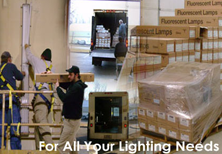Lighting Application Series: Efficient Multi-Housing Lighting
There are three main concerns about the lighting in and around multi-housing property. Namely, multi-housing lights must promote safety, be attractive, and be efficient. These factors are of utmost importance, because owners and property managers need to provide a safe, aesthetically pleasing space if they hope to attract and keep quality tenants. However, no one wants to send electric costs sky high in the process — this is where efficiency comes in. Currently, LEDs are the best option for achieving these three necessities, and they can do so without breaking the bank or requiring major renovations. To learn why they are such an intelligent choice for multi-housing lighting, let’s discuss a little of what makes them special and how you can use them in your multi-housing complex.
Use LEDs for Efficient Multi-Housing Lighting
Energy efficiency is a top concern for any multi-housing site, and lighting accounts for a significant chunk of any electric bill. Thus, it makes sense to choose the most efficient luminaires possible, as they will reduce energy costs and be kinder to the environment. LEDs are the most efficient lights on the market today, but of course, the question remains of whether upgrading to LEDs will have a fast enough ROI to make the investment worthwhile. In most cases, we think it is a smart investment, and here’s why:
- Instant Savings – LEDs only require 2 to 17 watts of energy, which is a mere fraction of what’s needed for fluorescents, incandescents, sodium, and metal halide bulbs. When you combine this reduction in energy across the many bulbs throughout a multi-housing site, it can add up to major savings.
- It’s Quick – Retrofitting is fast and easy, and in some cases only the bulbs need to be swapped out. In other words, no costly or extensive renovations are required.
- Long Lives – LEDs can last 10 times (or more) longer than many traditional bulbs, which means fewer replacement costs as well as less time and money devoted to maintenance.
- Rebates – Some state agencies and utility companies offer rebates for upgrading to Energy Star rated products. This can lower the initial investment of the lighting project.
Every ROI is different, and your specific ROI will depend on how many kilowatt hours you actually end up saving per day combined with other things, such as how long the bulbs last, rebates, and reduced maintenance costs. However, it’s not uncommon for those in the multi-housing industry to see a return on their LEDs in as little as one to two years. Even those who only make minor upgrades can see a return in ten years. Regardless of how long it takes for your investment to payoff, you will immediately enjoy lower electric bills and can proudly advertise your business’ green initiatives.
Smart Multi-Housing Lighting is Safe
Dim and difficult to see places discourage residents from moving into your building and put those who already live there at risk. In short, protect your business and your occupants by always having adequate lights and promptly replacing bulbs that burn out or become too dim. Here are some of the ways LEDs can promote safety:
- Don’t “Burn” Out – Although LEDs will gradually fade in brightness over time, they’ll never burn out in an instant like other technologies. This means no area of your property will unexpectedly be without light (unless there’s some other loss of power), and you can maintain adequate light levels at all times.
- Light Where You Need It – Thanks to recent LED advancements, there are now many styles of LEDs on the market, with some offering multi-directional light and others providing omni-directional light. So, whether you need ambient light over a wide area or would like to illuminate a particularly dark area of the parking lot, there is an LED to get the job done.
- Integrate with Other Safety Systems – LEDs are fully compatible with motion sensors or other safety features. They are capable of instantly turning on and off and doing so repeatedly without suffering loss of life.
- Available in High CRIs – A high color rendering index (80 or higher) is recommended for security areas. LEDs are available in high CRIs, with some rated 90+.
So, where are the most important places to put lights to make your building safe? Well, every multi-housing complex should have well-lit parking lots, outdoor spaces, hallways, primary and secondary entrances, and other common areas. Even adding accent lights in the landscaping or along the sides of the building can make less-traversed areas more secure and less appealing to ne’er-do-wells. In some cases, having too many or improperly placed lights can cause glares that pose their own safety risks, particularly to drivers. Your lighting professional can help you determine the best distribution and filters for your environment.
Intelligent Multi-Housing Lighting is Attractive
Costs, safety, and other practical things aside, people want to have lights that are appealing and easy on the eyes. The good news is that LEDs come in colorings capable of matching the ambiance of any location and are flexible enough to work in everything from a standard ceiling mounted fixture to an elegant chandelier. LEDs make a great aesthetic choice because they have:
- Natural Coloring – As mentioned, LEDs have a high CRI and appear very close to natural sunlight. LEDs can have CRIs of 90+, whereas fluorescents only reach to the 60 or 70 level. Natural-looking light is not only easier on the eyes, it more accurately produces the colors on carpets, fabrics, paint, and other decor.
- Low Profile – Because LEDs are small, you can integrate them virtually anywhere you see fit, including under ledges, along hand rails, above artwork, and more.
- Variety of Looks – LEDs are now made to look like candelabra bulbs, traditional incandescents, and everything in between. While they were once something to be hidden behind a fixture, they are now an element of design.
Starting with good, quality bulbs is the first step to improving the lighting aesthetics of your multi-housing property. From there, consider using lights to highlight the unique architectural elements or points of interest in your space. Accents lights work well for this, as you can put them anywhere and direct them to precise spots. Furthermore, low-profile lights in hallways, decorative fixtures along paths, and uplights in dark corners can all add visual appeal. If you don’t have an eye for design or know what’s available, an interior decorator or lighting professional can be a great resource for coming up with a beautiful lighting layout.
Extras
In addition to the above, there are a few other things you may want to consider when planning your intelligent multi-housing lighting plant. For instance, you may want to include things like dimmers and occupancy sensors in rooms that don’t need constant lighting. Also, you may want to opt for flush mount fixtures instead of recessed, since recessed varieties tend to let more conditioned air from the room escape into the ceiling. If you do use recessed lights, make sure and select those labeled as ICAT (insulation-contact, air-tight) fixtures. These extra steps can help you cut energy costs even further and reach that ROI a little faster.
Finally, keep in mind that the majority of the lights on the housing site are likely located inside people’s personal living spaces. To get the maximum benefit, think about retrofitting the entire building or offering some type of incentive to tenants who switch to LED. It will undoubtedly take more effort than just retrofitting outdoor and common areas, but will be the quickest way to get the huge drop in energy that you desire.



No comments yet.